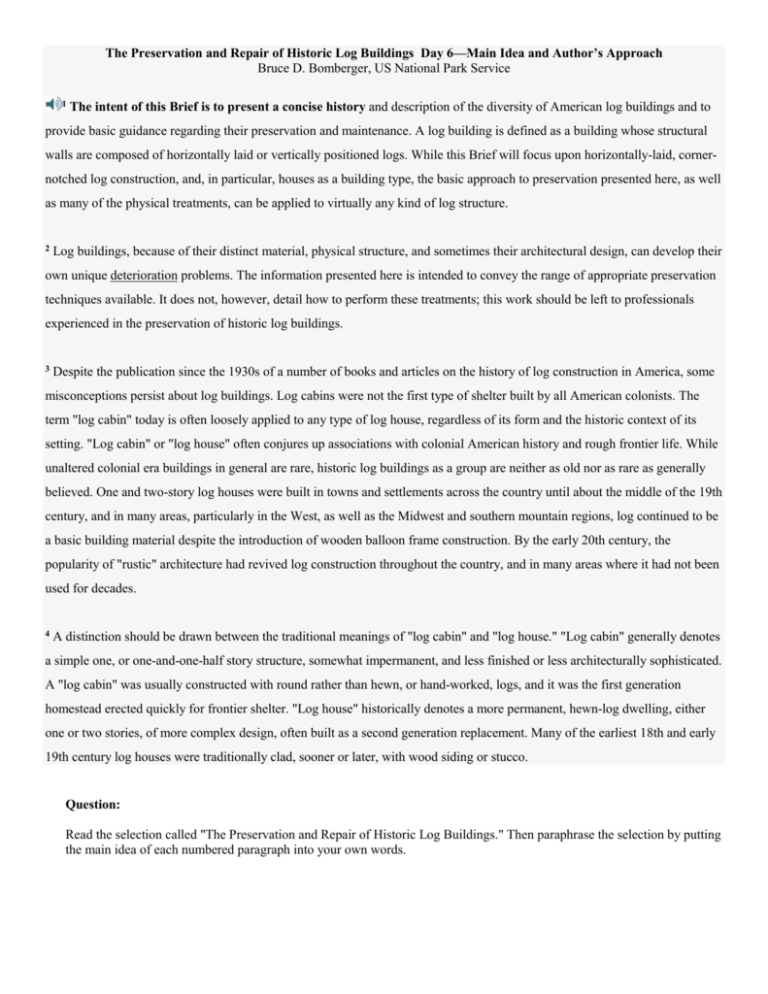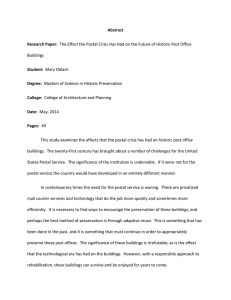The Preservation and Repair of Historic Log Buildings Day 6—Main
advertisement

The Preservation and Repair of Historic Log Buildings Day 6—Main Idea and Author’s Approach Bruce D. Bomberger, US National Park Service 1 The intent of this Brief is to present a concise history and description of the diversity of American log buildings and to provide basic guidance regarding their preservation and maintenance. A log building is defined as a building whose structural walls are composed of horizontally laid or vertically positioned logs. While this Brief will focus upon horizontally-laid, cornernotched log construction, and, in particular, houses as a building type, the basic approach to preservation presented here, as well as many of the physical treatments, can be applied to virtually any kind of log structure. 2 Log buildings, because of their distinct material, physical structure, and sometimes their architectural design, can develop their own unique deterioration problems. The information presented here is intended to convey the range of appropriate preservation techniques available. It does not, however, detail how to perform these treatments; this work should be left to professionals experienced in the preservation of historic log buildings. 3 Despite the publication since the 1930s of a number of books and articles on the history of log construction in America, some misconceptions persist about log buildings. Log cabins were not the first type of shelter built by all American colonists. The term "log cabin" today is often loosely applied to any type of log house, regardless of its form and the historic context of its setting. "Log cabin" or "log house" often conjures up associations with colonial American history and rough frontier life. While unaltered colonial era buildings in general are rare, historic log buildings as a group are neither as old nor as rare as generally believed. One and two-story log houses were built in towns and settlements across the country until about the middle of the 19th century, and in many areas, particularly in the West, as well as the Midwest and southern mountain regions, log continued to be a basic building material despite the introduction of wooden balloon frame construction. By the early 20th century, the popularity of "rustic" architecture had revived log construction throughout the country, and in many areas where it had not been used for decades. 4 A distinction should be drawn between the traditional meanings of "log cabin" and "log house." "Log cabin" generally denotes a simple one, or one-and-one-half story structure, somewhat impermanent, and less finished or less architecturally sophisticated. A "log cabin" was usually constructed with round rather than hewn, or hand-worked, logs, and it was the first generation homestead erected quickly for frontier shelter. "Log house" historically denotes a more permanent, hewn-log dwelling, either one or two stories, of more complex design, often built as a second generation replacement. Many of the earliest 18th and early 19th century log houses were traditionally clad, sooner or later, with wood siding or stucco. Question: Read the selection called "The Preservation and Repair of Historic Log Buildings." Then paraphrase the selection by putting the main idea of each numbered paragraph into your own words.











